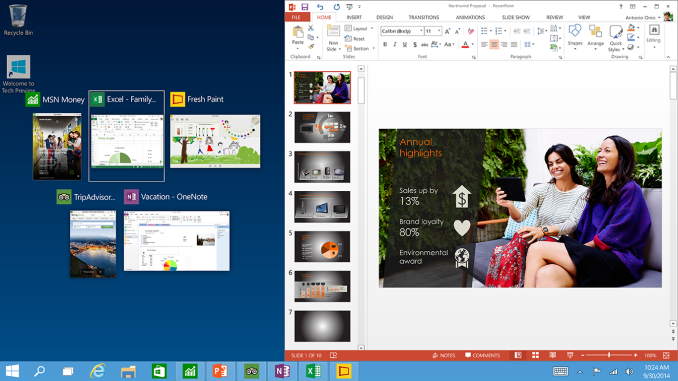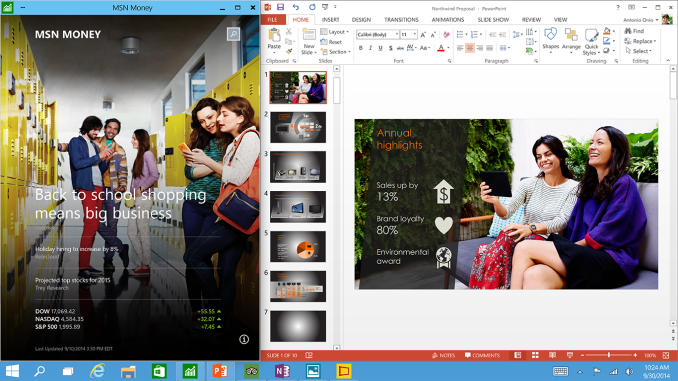Windows 10 Technical Preview First Impressions: The Return Of The Desktop
by Brett Howse on November 13, 2014 8:00 AM EST- Posted in
- Software
- Microsoft
- Windows 10
Closing Thoughts
If Windows 8 was “Touch First” then clearly Windows 10 is not. The current technical preview is very much geared towards the traditional mouse and keyboard user. This will change of course over the next several months, as the touch features get integrated back into Windows 10. As a user of all types of Windows devices, I welcome this change. It allows me to be more productive on my desktop, but still use the touch based Start Screen on a tablet or convertible notebook. Some good things have been done here to hopefully embrace the current user base, as well as new device types.
There are a number of features aimed squarely at businesses. If Microsoft wants to avoid another Windows XP with Windows 7 – where businesses do not migrate until they absolutely have to – then these features are certainly a carrot that may entice them to at least try it out. The Start Menu and other desktop additions will be great for the business users, and I think the IT crowd will be happy with a lot of the new additions around device management, identity management, and information management.
This is a technical preview of course, but still I would be remiss to not mention that it is not without its bugs. I have had a lot of issues with Windows Store apps, with many of them crashing especially when they are not the active window. Possibly there are some changes to the underlying WinRT framework for apps in standby but until we hear more about the framework changes then these problems will likely continue. More of this information should come out around the time of the next BUILD conference, scheduled for April 29th to May 1st 2015. Other issues with WinRT apps currently is that even though they can be used in a window, the absolute height of the window is limited. When Windows 8 was launched, WinRT apps were expecting to be either full screen, or snapped to the side. As such, the apps in a window must maintain a minimum height. Hopefully this can get sorted out in the future.
At first glance, Windows 10 looks like Windows 8 with a Start Menu. It is clearly a lot more than that, but even so, as someone very smart told me, that’s not a bad thing. Windows 8 had a lot going for it, but design decisions were made early on, and with a “my way or no way” attitude that it was difficult to use. It seems that Windows 10 really addresses a lot of this, while at the same time keeping and expanding on a lot of the great features that were in Windows 8 and likely overlooked due to a lot of animosity towards it.
The Windows Store is going to be a big part of this, and if the rumors of desktop apps being integrated into the store is true, then the OOBE for Windows 10 will be amazing. All of your settings and apps will now follow you from device to device, with a single log in. A lot of that is already there with Windows 8, but 10 should finish off the last remaining pieces if this is true. It makes a lot of sense, so unless the licensing terms are awful, this could be a fantastic addition to the store.
The Universal App model is also a big piece of the puzzle, but here there is more work to do. WinRT has a lot of advantages, but the framework needs to be updated at a rapid pace in order to draw developers in. It is somewhat seductive to be able to target desktops, laptops, tablets, phones, and the TV with Xbox One with a single application (with multiple interfaces of course) but until the framework is made powerful enough for more apps than just simple web front ends, it may be difficult to realize this idea. Once again, more info should be available at BUILD in regards to this.
I’ve also had some bugginess with the WinRT apps on Windows 8, which I hope will be fixed with Windows 10. At this point though, the WinRT apps are even buggier so likely there will be more pain before this is all corrected.
Although we have only seen the Technical Preview and a single update to it so far, you can see the potential for Windows 10 and what it will be able to accomplish. It is an ambitious goal to provide a single platform across such a swath of different devices, and one that was held back by the user interface before. With Continuum, it appears that it may be the best of both worlds. Even more exciting is how much more upfront and open Microsoft has been on this entire process, with not just the technical preview but also soliciting and requesting user feedback on the changes. One of the biggest change requests was a simple animation on the Start Menu, and that has already been implemented, so this really is a different world than when Windows 8 was given a sneak peek.
Due to the timing of the latest release that just came out, this article is based on the second build of Windows 10 and I have not had a chance to go over any of the changes in the latest built that arrived on November 12th.
Going forward, as we get more updates to the preview we will do our best to keep you fully informed with that the changes are, and how they will affect you. If you want to kick the tires of Windows 10 and you have not yet, just visit http://preview.windows.com and sign up for the technical preview.












198 Comments
View All Comments
Imaginer - Thursday, November 13, 2014 - link
I personally WANT to KEEP the Start Screen on my desktop systems.The All Apps area does need improvement, in zeroing in on the selected folders when zooming out (by CTRL mouse wheel). The folders do need to be differentiated by color boxes.
I have absolutely no use of launching any application by desktop icons anymore, only using this area for scratch files I use.
And I have no need for a limited Start Menu pinning, where on the Start Screen I can pin an "infinite" amount of tiles, with a quick reveal with the Start key or the Start button.
Options. I know that it can be given. Much like there is backlash, I am giving my own if I do not keep my Start Screens on my pure desktop PCs. Otherwise, the rejoice of "return of desktop" is unwarranted, as FIle Explorer, Task Manager, Right Click power options, and Taskbar are all there to begin with.
Imaginer - Thursday, November 13, 2014 - link
I really am not that interested in drop shadows, but it is a graphical draining feature I can turn off, as in my Tablet PC of a Surface Pro 2, most if not all the time I am running windows maximized. And on the desktop, most to all of my monitors run as close to maximized.I don't mind that flat look, it is superficial at this point, to appease the "prettiness" type of people.
Brett Howse - Thursday, November 13, 2014 - link
You can use the Start Screen instead of the Start Menu it's just a checkbox in the Start Menu properties. Once Continuum appears, it will be even easier to switch since you can likely manually invoke that feature.zero2dash - Thursday, November 13, 2014 - link
I've played around with it in a VM, and it's certainly better than 8/8.1 but I don't think it's any better than 7 and I'm happy with (and used to) 7. Even if 10 is a free upgrade for 7 users, I don't think I'd take it.Seems like they've moved things around a bit in 10 (that may have also been moved in 8/8.1 and are simply in the same spot in 10), and I don't like this "relearning" that they think I have the time or energy to do. If I'm going to relearn an OS, it's gonna be Ubuntu or Fedora.
Zingam - Thursday, November 13, 2014 - link
On my left - a laptop with Windows 8.1 and on my right - a laptop with Windows 7. Conclusion: Windows 8.1 is so much nicer than Windows 7 (Windows 8 was lacking but Windows 8.1 is superior). Nuff said!Gunbuster - Thursday, November 13, 2014 - link
Is DirectAccess in the preview or do they have it locked down to "Windows 10 Enterprise" or whatever they are going to call it?I'm convinced Cisco is making payments to keep DirectAccess out of the mainstream so their VPN device customers don't instantly evaporate.
wiyosaya - Thursday, November 13, 2014 - link
In my opinion, overall cost is what drives business to move to a new OS, not features. Many businesses had only recently upgraded from NT to 7 when 8 came out. M$ seems to expect that everyone, including the business world, will just lock-step into line and upgrade at M$' slightest whim.As I see it, even without the learning curve of the new UI in 8, upgrading, after just completing an upgrade to 7, would have been prohibitively expensive for many businesses. Many articles I have seen point to the learning curve of the 8 UI as the singular reason that the business world failed to adopt it. What evidence is there for this? I am willing to bet that the main reason was cost, not learning curve - which is not all that steep except, perhaps, for the less technically inclined.
Hairs_ - Thursday, November 13, 2014 - link
The biggest hurdle for businesses is app compatibility, even more so than hardware or training costs.Businesses are still running mission critical functions on 70's mainframe systems, because replacing them is simply too expensive / frightening / difficult.
prime2515103 - Thursday, November 13, 2014 - link
Can the live tiles in the start menu be disabled and/or replaced with the selections that are in the Win7 start menu?Brett Howse - Thursday, November 13, 2014 - link
You can unpin whatever you would like from the Start Menu, and you can pin anything you'd like including desktop apps.